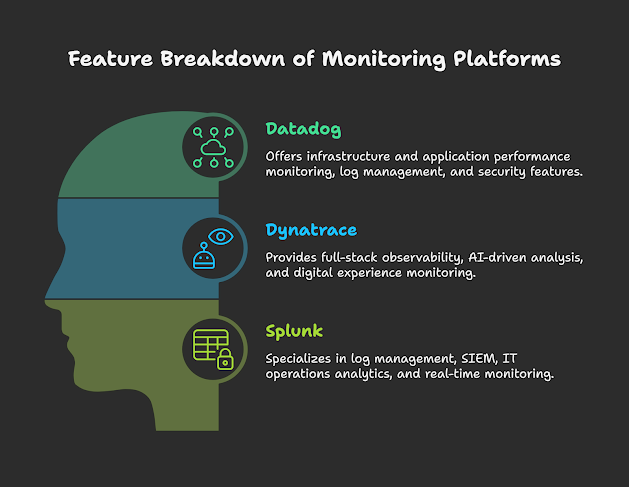In the realm of observability and monitoring, Datadog, Dynatrace, and Splunk stand as prominent players. Each platform offers unique strengths and caters to different needs, making the selection process a critical decision. This article provides a detailed comparison, covering fundamental aspects, key features, performance, pricing, integrations, security, and customer support.
1. Understanding the Basics:
Datadog:
A cloud-based monitoring and security platform that provides observability for applications, infrastructure, and logs.
Known for its intuitive interface, extensive integrations, and real-time analytics.
Strong in cloud-native environments and microservices architectures.
Dynatrace:
An AI-powered observability platform that automates performance monitoring and root cause analysis.
Focuses on providing deep insights into application performance and user experience.
Emphasizes automatic discovery and dependency mapping.
Splunk:
A data analytics platform that excels at ingesting and analyzing massive volumes of machine-generated data.
Offers powerful search and reporting capabilities for logs, metrics, and events.
Highly versatile and used for security, IT operations, and business analytics.
.png)
2. Key Features of Each Platform:

Datadog:
Infrastructure monitoring (servers, containers, cloud services)
Application performance monitoring (APM)
Log management
Real User Monitoring (RUM)
Security monitoring (Cloud Security Management, Threat Detection)1
Synthetic monitoring
Cloud SIEM abilities.
Dynatrace:
Full-stack observability with automatic discovery
AI-powered root cause analysis (Davis AI)
Application security
Real User Monitoring (RUM) and digital experience monitoring (DEM)
Infrastructure monitoring
Cloud automation.
Splunk:
Log management and analytics
Security Information and Event Management (SIEM)
IT operations analytics (ITOA)
Business analytics
Real-time monitoring and alerting
Powerful search language (SPL).
.png)
3. Performance and Speed Comparison:
Datadog:
Known for its real-time data ingestion and fast query performance.
Highly scalable and suitable for large-scale environments.
Excellent for monitoring dynamic and distributed systems.
Dynatrace:
Emphasizes automatic discovery and AI-driven analysis, which can reduce the time to detect and resolve issues.
Provides deep insights into application performance with minimal overhead.
Davis AI allows for very fast root cause analysis.
Splunk:
Handles massive volumes of data, but query performance can vary depending on data volume and complexity.
Optimized for search and analysis of historical data.
Very powerful search language allows for very complex data analysis.
.png)
4. Pricing Structure Analysis:
.png)
Datadog:
Usage-based pricing, with separate costs for different products and features.
Offers flexible pricing options, but costs can escalate with high data volume and usage.
Pricing is typically based on hosts, events, and API calls.
Dynatrace:
Simplified pricing based on Digital Performance Management (DPM) units.
Includes all features in a single platform, but can be more expensive than Datadog for basic monitoring needs.
Pricing is based on host units.
Splunk:
Pricing based on data ingestion volume (per GB per day).
Offers various licensing options, including perpetual and term licenses.
Can be expensive for high data volumes, but offers powerful analytics capabilities.
Splunk also offers workload based pricing.
5. Integration Capabilities:
.png)
Datadog:
Extensive library of integrations with cloud services, databases, and other tools.
Easy to integrate with popular DevOps tools and platforms.
Strong API support.
Dynatrace:
Automatic discovery and integration with cloud platforms and technologies.
Focuses on deep integration with application frameworks and runtimes.
Very good integration with cloud native technologies.
Splunk:
Wide range of integrations through Splunkbase apps and add-ons.
Supports various data sources and formats.
Strong API and SDK support.
6. Security and Compliance Standards:
Datadog:
SOC 2 Type II, ISO 27001, and GDPR compliance.
Offers security monitoring and threat detection capabilities.
Strong focus on data security and privacy.
Dynatrace:
SOC 2 Type II, ISO 27001, and GDPR compliance.
Provides application security and vulnerability management features.
Emphasizes data encryption and access control.
Splunk:
SOC 2 Type II, ISO 27001, and GDPR compliance.
Offers robust security information and event management (SIEM) capabilities.
Strong focus on security analytics and threat detection.
7. Datadog's Customer Support:
Known for responsive and helpful customer support.
Offers various support channels, including email, chat, and phone.
Provides extensive documentation and community resources.
Dynatrace and Splunk also have very good support structures.
8. Final Verdict: Which is Best for Your Needs?
.png)
Datadog:
Ideal for cloud-native environments, microservices, and DevOps teams.
Excellent for real-time monitoring and alerting.
Suitable for organizations that require a flexible and scalable platform.
Dynatrace:
Best for organizations that prioritize AI-powered observability and automated root cause analysis.
Suitable for complex applications and environments that require deep performance insights.
Great for organizations that want a solution that handles most of the configuration automatically.
Splunk:
Ideal for organizations that need to analyze massive volumes of machine-generated data.
Excellent for security information and event management (SIEM) and IT operations analytics (ITOA).
Best for organizations that require powerful search and reporting capabilities.
Splunk is very good for organizations that have complex data analysis needs.
In summary:
If you need real-time monitoring and a wide range of integrations in a cloud native enviroment, choose Datadog.
If you need AI-powered automation and deep performance insights, choose Dynatrace.
If you need to analyze massive volumes of data and require powerful search and security capabilities, choose Splunk.
The best choice depends on your specific requirements, budget, and technical expertise. Consider your organization's needs and evaluate each platform thoroughly before making a decision.






No comments:
Post a Comment